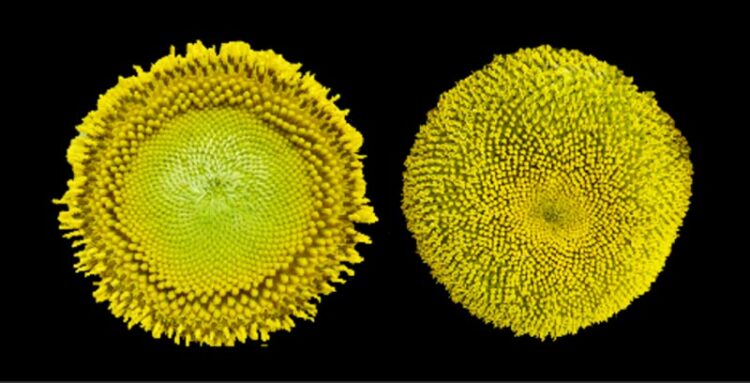Circadian clock controls sunflower blooms, optimizing for pollinators

On the left, a sunflower head grown under normal conditions. Florets open in concentric circles from the outer rim. On right, a sunflower head grown under conditions to disrupt the circadian clock shows florets opening in a gradient from oldest (outside) to the center.
Credit: Stacey Harmer, UC Davis
An internal circadian clock controls the distinctive concentric rings of flowering in sunflowers, maximizing visits from pollinators, a new study from plant biologists at the University of California, Davis shows. The work is published Jan. 13 in eLife.
A sunflower head is made up of hundreds of tiny florets. Because of the way sunflowers grow, the youngest florets are in the center of the flower face and the most mature at the edges, forming a distinctive spiral pattern from the center to the edge.
An individual floret blooms over a couple of days: on the first day, it opens the male part of the flower and presents pollen; on the second day, the female stigma unfold to receive pollen. Somehow, florets coordinate so that they open in concentric rings starting from the edge and moving inwards on successive days, with a ring of female flowers always outside the earlier-stage, pollen-bearing male flowers.
Pollinating bees tend to land on the ray petals around a sunflower head and walk towards the center, said senior author Stacey Harmer, professor of plant biology, UC Davis College of Biological Sciences. That means that they will pick up pollen after they have walked over the female florets, then carry it to a different flower head.
Harmer and postdoctoral researcher Carine Marshall wanted to understand how the spiral pattern of florets turns into concentric rings of flowering. Harmer’s lab had previously established that circadian rhythms control how growing sunflowers track the sun during the day.
The internal circadian clock of a plant or animal runs on a cycle of about 24 hours, allowing different genes to be activated at different times of day. Natural day/night cycles keep this internal clock synchronized to actual day time. Changing the length or day light, or darkness, can reset the clock. In sunflowers, continuous light disrupts the clock entirely.
Time lapse video
The researchers took time-lapse videos of sunflowers grown in different light/dark or temperature conditions. They found that the plant’s circadian clock controls the opening of florets. When the clock was disrupted by growing plants in continuous light, florets did not open in concentric rings, but only by age, starting at the edge and moving to the center in a continuous gradient.
Two yellow sunflower heads against a black background. The flowerhead on left shows concentric rings.
At left is as sunflower head grown under normal conditions. Florets mature in concentric rings day by day. The flower head at right was grown with a disrupted circadian clock and its florets did not open in the correct pattern. (Harmer lab, UC Davis)
When plants that had been grown with a disrupted clock were moved outside, they attracted fewer pollinators than normal sunflowers.
“We think that being able to coordinate in this way makes them a better target for bees,” Harmer said. “It’s a strategy to attract as many insects as possible.”
As farmers adapt to a changing climate, it will become increasingly important to make pollination as efficient as possible in crops that require it, Harmer said. Understanding how the circadian clock and the environment affect flowering will help breeders develop cultivars that flower at the optimal times of day to promote pollination, despite climate change and declining insect populations, she said.
Additional authors on the paper are Veronica Thompson and Nicky Creux. Creux is now at the University of Pretoria, South Africa. The work was supported by the National Science Foundation and the U.S. Department of Agriculture-National Institute of Food and Agriculture.
Journal: eLife
DOI: 10.7554/eLife.80984
Method of Research: Experimental study
Subject of Research: Not applicable
Article Title: The circadian clock controls temporal and spatial patterns of floral development in sunflower
Article Publication Date: 13-Jan-2023
COI Statement: None declared.
Media Contact
Andrew Fell
University of California – Davis
ahfell@ucdavis.edu
Office: 530-752-4533
Cell: 530-304-8888
All latest news from the category: Life Sciences and Chemistry
Articles and reports from the Life Sciences and chemistry area deal with applied and basic research into modern biology, chemistry and human medicine.
Valuable information can be found on a range of life sciences fields including bacteriology, biochemistry, bionics, bioinformatics, biophysics, biotechnology, genetics, geobotany, human biology, marine biology, microbiology, molecular biology, cellular biology, zoology, bioinorganic chemistry, microchemistry and environmental chemistry.
Newest articles

A universal framework for spatial biology
SpatialData is a freely accessible tool to unify and integrate data from different omics technologies accounting for spatial information, which can provide holistic insights into health and disease. Biological processes…

How complex biological processes arise
A $20 million grant from the U.S. National Science Foundation (NSF) will support the establishment and operation of the National Synthesis Center for Emergence in the Molecular and Cellular Sciences (NCEMS) at…

Airborne single-photon lidar system achieves high-resolution 3D imaging
Compact, low-power system opens doors for photon-efficient drone and satellite-based environmental monitoring and mapping. Researchers have developed a compact and lightweight single-photon airborne lidar system that can acquire high-resolution 3D…





















